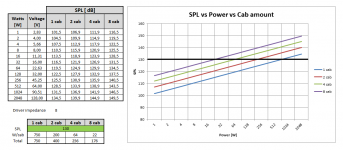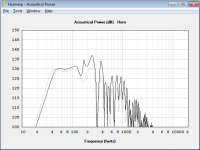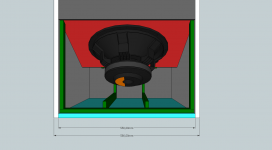Hi,
I'd like to share a simple graphic with obvious information that may help someone. Sometimes, even if we know the phenomena it is important to see some graphic to hold the information in our memory.
Now a days, there are many cabs with really high density power, I mean, thousands of watts/cab. But as side effect the power supply/AC plug can be serious overloaded like old electrical installations, residential AC plug 115/127V limited to 10A or 20A , and so on, so:
From the power supply point of view, what is better?
lets take a look at the attachment 1. The graphic represents the design SS15MOD loaded with different input watts and also different cab amount. If we consider 130 dB SPL as target (black line) we have:
So, in case AC power supply is a concern, the way to go to achieve higher SPL is to stack more cabs.
Some side effects are: space to storage and to handle, time to assembly, amp units, etc
.
I'd like to share a simple graphic with obvious information that may help someone. Sometimes, even if we know the phenomena it is important to see some graphic to hold the information in our memory.
Now a days, there are many cabs with really high density power, I mean, thousands of watts/cab. But as side effect the power supply/AC plug can be serious overloaded like old electrical installations, residential AC plug 115/127V limited to 10A or 20A , and so on, so:
From the power supply point of view, what is better?
Less cab with more power per drive or
more cab with less power per drive
lets take a look at the attachment 1. The graphic represents the design SS15MOD loaded with different input watts and also different cab amount. If we consider 130 dB SPL as target (black line) we have:
1 cab = 750 Watts/cab = 750 Watts total
2 cab = 200 Watts/cab = 400 Watts total
4 cab = 64 Watts/cab = 256 Watts total
8 cab = 22 Watts/cab = 176 Watts total
So, in case AC power supply is a concern, the way to go to achieve higher SPL is to stack more cabs.
Some side effects are: space to storage and to handle, time to assembly, amp units, etc
.
Attachments
So, in case AC power supply is a concern, the way to go to achieve higher SPL is to stack more cabs.
Some side effects are: space to storage and to handle, time to assembly, amp units, etc
.
It is my assumption that part of this has to do with cone excursion as well:
For a given SPL, pushing 4 cabs lightly should be more efficient than pushing 2 cabs hard, because it takes a lot of power to move a cone to its Xmax. In other words, I doubt the power curve is linear.
This is correct, yes?
Other benefits are lower distortion, and faster response.
Related to cabs stack, may I ask for more support?
. and when using four cabs?
Theoretically:
The floor is reflecting a lot of amplitude forward, and you want all of that reflection to be as in-phase as possible. So, put all ports as low as possible, and at the same level, if possible.
In reality, though, it might not make a huge difference, given the size of these waves.
LORDSANSUI,Hi,
I'd like to share a simple graphic with obvious information that may help someone.
1 cab = 750 Watts/cab = 750 Watts total2 cab = 200 Watts/cab = 400 Watts total4 cab = 64 Watts/cab = 256 Watts total8 cab = 22 Watts/cab = 176 Watts total
So, in case AC power supply is a concern, the way to go to achieve higher SPL is to stack more cabs.
Absolutely, more cabinets require less power to achieve the same SPL.
However, your graphic is not quite as impressive as it should be- each doubling of cabinets only requires 3 dB (half) the power to achieve the same SPL:
1 cab = 750 Watts/cab = 750 Watts total
2 cab = 187.5 Watts/cab = 375 Watts total
4 cab = 46.9 Watts/cab = 187.5 Watts total
8 cab = 11.7 Watts/cab = 93.75 Watts total
Or, in more easy to understand numbers:1 cab = 1000 Watts/cab = 1000 Watts total
2 cab = 250 Watts/cab = 500 Watts total
4 cab = 62.5 Watts/cab = 250 Watts total
8 cab = 15.625 Watts/cab = 125 Watts total
This assumes outdoor conditions and mutual coupling.
Last edited:
your graphic is not quite as impressive as it should be
All values were simulated with hornresp, power inputs and also multi cabs.
When doubling power we can confirm the +3 dB, while doubling cab looks like little different.
Odd, had never noticed that before. Oh well, "nothing's perfect" 😉 ...All values were simulated with hornresp, power inputs and also multi cabs.
When doubling power we can confirm the +3 dB, while doubling cab looks like little different.
Weltersys, is there anything strange that should remake the simulation or even check with David?
Below the graphic comparison between 1cab vs 8cab, the shape of the curve was slightly changed, and there are some improvements in the low frequencies. I read somewhere in the forum that it shouldn't happen for TH, just for FLH.
Black = 1cab @ 750 W
Gray = 8cab @ 22 W
Below the graphic comparison between 1cab vs 8cab, the shape of the curve was slightly changed, and there are some improvements in the low frequencies. I read somewhere in the forum that it shouldn't happen for TH, just for FLH.
Black = 1cab @ 750 W
Gray = 8cab @ 22 W
Attachments
I read somewhere in the forum that it shouldn't happen for TH, just for FLH.
I think you can safely ignore that. The sound coming out of a horn's mouth doesn't know that it's a TH or a FLH so I suspect that the behavior will be exactly the same when the number of cabinets is increased. What you might see is an unexpected increase at higher frequencies as well as Hornresp does not include the effect of the baffle step of the front face in its sim and for most THs the mouth does not take up the entire front face, and usually it takes up a lot less than that.
In any case, I did my own checks, measuring impedance of a TH cab out in the open and then against a wall (simulating two cabs side by side), and it shifted exactly as predicted by Hornresp, indicating that the loading and therefore the response of the TH will be different.
I have (years ago..) brought up the discrepancy between the LF extension in multiple TH simulated in Hornresp vs the measured lack of that effect with David. He's not going to change that "feature".Weltersys, is there anything strange that should remake the simulation or even check with David?
"Don't sweat the small stuff" 😀. Especially when it's free, and works "close enough for rock and roll!"
Art
To double-check that feature, I'd recommend running a simulation with 8x drivers, and multiply all the areas by 8. See what you get.
Chris
Chris
To double-check that feature, I'd recommend running a simulation with 8x drivers, and multiply all the areas by 8. See what you get.
Chris
Hi Chris, I'm confused about what you are suggesting. Let me make some comments so you may can clearify:
1) Run simulation with 8x drivers OK
2) multiply all the areas by 8 😕 you mean, simulate 1 cab/driver and then add 10*log(8)=9,03dB to the result and compare with 8x drivers?
How can I multiply the results? (SPL vs Frequency)
each doubling of cabinets only requires 3 dB (half) the power to achieve the same SPL
At low frequencies yes - exactly as shown in Hornresp 🙂.
Grey trace is 1000 watts into 1 cabinet
Green trace is 125 watts into 8 cabinets
Attachments
At low frequencies yes - exactly as shown in Hornresp 🙂.
Grey trace is 1000 watts into 1 cabinet
Green trace is 125 watts into 8 cabinets
Low frequency equivalents:
64 watts into 1 cabinet in 4 Pi space is the same as:
1. 8 watts into 8 cabinets in 4 Pi space.
2. 8 watts into 1 cabinet (with cabinet areas and volumes x 8) having 8 drivers in 4 Pi space.
3. 1 watt into 1 cabinet in 0.5 Pi space.
Hi Chris, I'm confused about what you are suggesting. Let me make some comments so you may can clearify:
1) Run simulation with 8x drivers OK
2) multiply all the areas by 8 😕 you mean, simulate 1 cab/driver and then add 10*log(8)=9,03dB to the result and compare with 8x drivers?
How can I multiply the results? (SPL vs Frequency)
Option 2 in my post above refers.
Thanks David
Could you indicate the upper limit of low frequency?
At your post #173 the green line and gray one were equal till ~130Hz, so this would the the limit, is there any reason for things being different after this frequency?
Low frequency equivalents:
Could you indicate the upper limit of low frequency?
At your post #173 the green line and gray one were equal till ~130Hz, so this would the the limit, is there any reason for things being different after this frequency?
Hi LORDSANSUI,
The upper limit of low frequency will depend upon the cabinets and drivers used.
At low frequencies, the acoustical impedance load with multiple cabinets will be greater than that with one cabinet. At high frequencies, the acoustical impedance load with multiple cabinets will tend towards that of one cabinet. In the attached example the light traces show the acoustical resistance and reactance for 1 cabinet and the dark traces show the acoustical resistance and reactance for 8 cabinets.
Kind regards,
David
Could you indicate the upper limit of low frequency?
The upper limit of low frequency will depend upon the cabinets and drivers used.
is there any reason for things being different after this frequency?
At low frequencies, the acoustical impedance load with multiple cabinets will be greater than that with one cabinet. At high frequencies, the acoustical impedance load with multiple cabinets will tend towards that of one cabinet. In the attached example the light traces show the acoustical resistance and reactance for 1 cabinet and the dark traces show the acoustical resistance and reactance for 8 cabinets.
Kind regards,
David
Attachments
Excellent build LordSansui, very impressive!
Can you tell me, what is the internal width of the cabinet, I can't see it in your CAD drawing.
I have all other measurements thank you.
Thanks for all your hard work and taking the time to share your progress with us all.
Can you tell me, what is the internal width of the cabinet, I can't see it in your CAD drawing.
I have all other measurements thank you.
Thanks for all your hard work and taking the time to share your progress with us all.
The upper limit of low frequency will depend upon the cabinets and drivers used.
Is there a feature in hornresp or a way to identify this The upper limit for a specific cab/driver?
Probably it can help to optimize SPL and Xover while using multiply cabs 😀

- Home
- Loudspeakers
- Subwoofers
- TH 15" flat response to 35Hz (-3dB) - By LORDSANSUI




